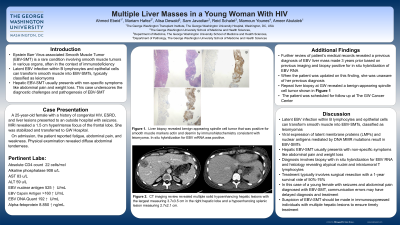Sunday Poster Session
Category: Liver
P1384 - Multiple Liver Masses in a Young Woman With HIV
Sunday, October 27, 2024
3:30 PM - 7:00 PM ET
Location: Exhibit Hall E

Has Audio

Ahmed Ebeid, MD
George Washington University
Arlington, VA
Presenting Author(s)
Ahmed Ebeid, MD1, Mariam Hafez, BS2, Alisa Dewald, BS2, Sam Javadian, BS2, Reid Schalet, DO2, Ameer Abutaleb, MD3
1George Washington University, Washington, DC; 2George Washington University School of Medicine and Health Sciences, Washington, DC; 3George Washington University Hospital, Washington, DC
Introduction: Epstein Barr Virus (EBV)-associated Smooth Muscle Tumor (SMT) is a rare condition involving smooth muscle tumors in various organs, often in the context of immunodeficiency. Latent EBV infection within B lymphocytes and epithelial cells can transform smooth muscle into EBV-SMTs, typically classified as leiomyosarcomas. Hepatic EBV-SMT usually presents with non-specific symptoms like abdominal pain and weight loss. This case underscores the diagnostic challenges and pathogenesis of EBV-SMT
Case Description/Methods: A 25-year-old female with a history of congenital human immunodeficiency virus (HIV), end-stage renal disease (ESRD), and liver lesions presented to an outside hospital with seizures. MRI revealed a 1.5 cm hyperintense focus of the frontal lobe. She was stabilized and transferred to GW Hospital.
Upon admission, the patient reported fatigue, abdominal pain, and weakness. Physical examination revealed diffuse abdominal tenderness. Initial labs indicated elevated alkaline phosphatase (908 u/L), aspartate aminotransferase (83 u/L), alanine aminotransferase (59 u/L), EBV nuclear antigen (525 U/mL), and EBV IgG antibodies (160 U/mL) (Table 1). The neurology and hepatology teams were consulted. The neurology team recommended a repeat MRI, which revealed no metastasis. The hepatology team reviewed prior imaging, revealing hepatic lesions. A biopsy at GW revealed siderosis and portal fibrosis, consistent with leiomyosarcoma. Additional labs revealed an elevated alpha-fetoprotein (Table 1). Further imaging review revealed a liver lesion documented 3 years prior with a biopsy positive on in situ hybridization for EBV RNA, of which the patient was unaware. Repeat testing from GW Hospital’s biopsy confirmed a diagnosis of EBV-SMT. The patient was recommended to follow up at GW Cancer Center.
Discussion: We presented a young female with seizures and abdominal pain, diagnosed with EBV-SMT due to immunosuppression from HIV and ESRD. Communication errors may have delayed diagnosis and treatment. EBV-SMT involves viral expression of latent membrane proteins (LMPs) and nuclear antigens, mediated by DNA mismatch repair mutations. Diagnosis is via biopsy with in situ hybridization for EBV RNA and histology showing atypical nuclei and intratumoral T lymphocytes. Treatment typically involves surgical resection. These slow-growing tumors have a 1-year survival rate of 50%-76%. Suspecting EBV-SMT in immunosuppressed individuals with hepatic lesions is important.
Note: The table for this abstract can be viewed in the ePoster Gallery section of the ACG 2024 ePoster Site or in The American Journal of Gastroenterology's abstract supplement issue, both of which will be available starting October 27, 2024.
Disclosures:
Ahmed Ebeid, MD1, Mariam Hafez, BS2, Alisa Dewald, BS2, Sam Javadian, BS2, Reid Schalet, DO2, Ameer Abutaleb, MD3. P1384 - Multiple Liver Masses in a Young Woman With HIV, ACG 2024 Annual Scientific Meeting Abstracts. Philadelphia, PA: American College of Gastroenterology.
1George Washington University, Washington, DC; 2George Washington University School of Medicine and Health Sciences, Washington, DC; 3George Washington University Hospital, Washington, DC
Introduction: Epstein Barr Virus (EBV)-associated Smooth Muscle Tumor (SMT) is a rare condition involving smooth muscle tumors in various organs, often in the context of immunodeficiency. Latent EBV infection within B lymphocytes and epithelial cells can transform smooth muscle into EBV-SMTs, typically classified as leiomyosarcomas. Hepatic EBV-SMT usually presents with non-specific symptoms like abdominal pain and weight loss. This case underscores the diagnostic challenges and pathogenesis of EBV-SMT
Case Description/Methods: A 25-year-old female with a history of congenital human immunodeficiency virus (HIV), end-stage renal disease (ESRD), and liver lesions presented to an outside hospital with seizures. MRI revealed a 1.5 cm hyperintense focus of the frontal lobe. She was stabilized and transferred to GW Hospital.
Upon admission, the patient reported fatigue, abdominal pain, and weakness. Physical examination revealed diffuse abdominal tenderness. Initial labs indicated elevated alkaline phosphatase (908 u/L), aspartate aminotransferase (83 u/L), alanine aminotransferase (59 u/L), EBV nuclear antigen (525 U/mL), and EBV IgG antibodies (160 U/mL) (Table 1). The neurology and hepatology teams were consulted. The neurology team recommended a repeat MRI, which revealed no metastasis. The hepatology team reviewed prior imaging, revealing hepatic lesions. A biopsy at GW revealed siderosis and portal fibrosis, consistent with leiomyosarcoma. Additional labs revealed an elevated alpha-fetoprotein (Table 1). Further imaging review revealed a liver lesion documented 3 years prior with a biopsy positive on in situ hybridization for EBV RNA, of which the patient was unaware. Repeat testing from GW Hospital’s biopsy confirmed a diagnosis of EBV-SMT. The patient was recommended to follow up at GW Cancer Center.
Discussion: We presented a young female with seizures and abdominal pain, diagnosed with EBV-SMT due to immunosuppression from HIV and ESRD. Communication errors may have delayed diagnosis and treatment. EBV-SMT involves viral expression of latent membrane proteins (LMPs) and nuclear antigens, mediated by DNA mismatch repair mutations. Diagnosis is via biopsy with in situ hybridization for EBV RNA and histology showing atypical nuclei and intratumoral T lymphocytes. Treatment typically involves surgical resection. These slow-growing tumors have a 1-year survival rate of 50%-76%. Suspecting EBV-SMT in immunosuppressed individuals with hepatic lesions is important.
Note: The table for this abstract can be viewed in the ePoster Gallery section of the ACG 2024 ePoster Site or in The American Journal of Gastroenterology's abstract supplement issue, both of which will be available starting October 27, 2024.
Disclosures:
Ahmed Ebeid indicated no relevant financial relationships.
Mariam Hafez indicated no relevant financial relationships.
Alisa Dewald indicated no relevant financial relationships.
Sam Javadian indicated no relevant financial relationships.
Reid Schalet indicated no relevant financial relationships.
Ameer Abutaleb indicated no relevant financial relationships.
Ahmed Ebeid, MD1, Mariam Hafez, BS2, Alisa Dewald, BS2, Sam Javadian, BS2, Reid Schalet, DO2, Ameer Abutaleb, MD3. P1384 - Multiple Liver Masses in a Young Woman With HIV, ACG 2024 Annual Scientific Meeting Abstracts. Philadelphia, PA: American College of Gastroenterology.
